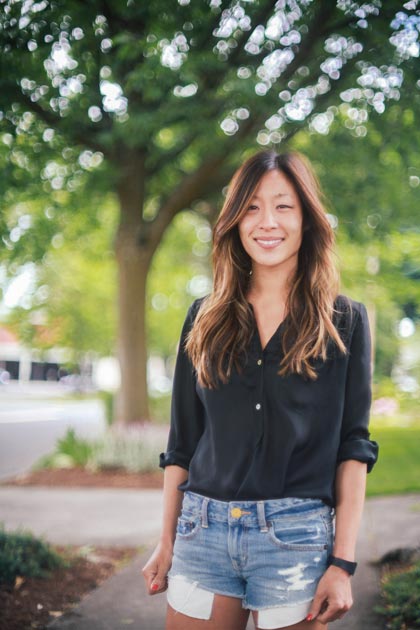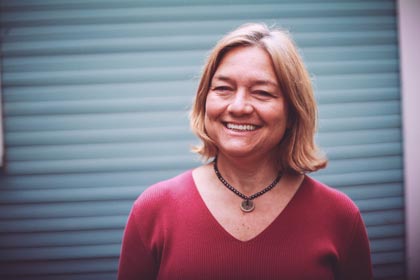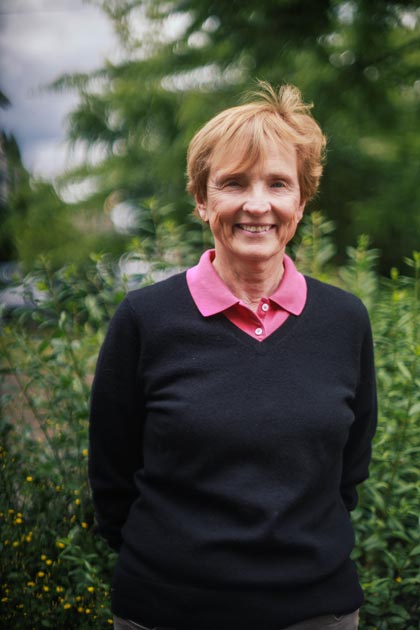The U.S. is approaching a defining moment of change in transportation, and Eugene is no exception. For the first decade of the last six, the average American is beginning to cut vehicle miles traveled, and the demand for a shorter commute is on the rise with younger generations. Biking is on the rise nationwide. In the last eight years, Oregon’s gas and diesel tax revenue has dropped by about 1 percent, while the amount coming from Eugene has dropped by 15 percent. Changes are afoot.
 |
|
‘It’s been really interesting to work with all these pretty influential people and get an idea of the work that’s being done out there, and potentially work that we could get into.’ — Meghan Nelson, graduate student
|
 |
| ‘I think the community is primed for implementing bike-sharing throughout the city.’ — Ann Scheerer, Ph.D. candidate and UO instructor |
 |
|
‘It’s designed to take students, people who are interested in sustainability and cities, from diverse backgrounds and give them some applied skills so they can go get a job.’ — Vicki Elmer, OLIS director
|
At the same time, carbon dioxide levels are skating on the edge of the 400 ppm mark, a symbolic milestone that last occurred several million years ago, when Earth had a hot climate, an ice-free Arctic and seas 40 meters higher. The situation is serious enough that small transportation changes aren’t good enough, and climate experts say our behaviors have to change more.
But how do we get to the place where alternatives to the typical way we get around become the norm? A new Sustainable Transportation Projects course at the University of Oregon is attacking those problems right here in Eugene, and its students are the ones who want to use our local laboratory, aka the streets of Eugene, to redesign the system and help curb climate change. Their projects look at everything from the bike economy to pay-as-you-go car insurance to bike-sharing a la Paris and NYC.
Meet OLIS
The UO graduate certificate program Oregon Leadership in Sustainability (OLIS) trains students to be sustainability consultants, and it introduced the new sustainable transportation course this winter, funded by grants from the Oregon Transportation Research and Education Consortium. Program Director and former Eugene city manager Vicki Elmer calls OLIS a one-year boot camp in sustainability. “It’s designed to take students, people who are interested in sustainability and cities, from diverse backgrounds and give them some applied skills so they can go get a job.” So far, she says, it’s been a success.
Elmer says that in designing the course, OLIS instructors found other transportation planning classes, but none that covered the core elements of sustainability: equity, economics and environment. The class is the only one she knows of that works with a university’s community on applied projects.
OLIS is teaching her, too, Elmer says. “I learned that even the most conservative communities who don’t believe in climate change can still embrace a more transit-oriented approach to land-use development,” she says. “I’m specifically speaking about communities in Utah that have done something called Envision Utah.” Like Envision Eugene, communities are asked to participate in urban planning. In the case of Utah, a very conservative, pro-car, pro-development community embraced a mass transit system after learning that they wouldn’t be able to sustain more development without one. “It’s not just the bailiwick of people on the left — climate change solutions in the transportation arena can be embraced by people of all sorts of persuasions,” she continues. “We don’t need to stereotype.”
Sustainable Transportation Projects partners students, who act as consultants, with their transit-professional clients, such as the city of Eugene, Lane Transit District and UO. They tackle projects that the clients have wanted to examine but haven’t had the funding or hours to dig into. The inaugural term’s projects looked at reduction in Eugene gas and diesel consumption, impacts of bicycling on the Eugene economy, Eugene development requirements for parking, UO transportation strategies and goals, bike-sharing expansion feasibility and pay-as-you-drive car insurance.
Bike-Share
Ann Scheerer, the Ph.D. candidate who taught the class, says that the projects were small in scope because of the 10-week term time limit, but many of the projects raised questions that future classes can take further.
Scheerer says that one of the projects she thinks has potential to move forward is bike-sharing, something Paris has already developed successfully and that New York City is rolling out now. New technology enables bike-share members to check bikes out of kiosks that would be located around denser parts of town, their names and credit card numbers associated with each check-out. “If you’re a member of a bike-share, they’re counting on you doing half-hour trips or less, so it’s not a long-term rental situation.” Scheerer says. “It would be more for replacing those short trips,” and useful for those who reached downtown by carpool or don’t want to move their cars.
The biggest challenge, she says, is that the program needs to be run as a nonprofit by a passionate director. “If someone out there was a real bike-share proponent that had the executive director skills that could pull it together, I think the community is primed for implementing bike-sharing throughout the city.” In fact, Rob Inerfeld, the city of Eugene’s transportation planning manager, says that the energy is there, and the city and LTD are applying for a grant to start the project.
Inerfeld and his staff were clients for three of the student projects: bike-sharing, parking needed for multi-family developments and the impact of biking on local businesses. He says the city will use the results of the projects when the city works on updating its transportation plan.
Silicon Shire & the Creative Class
Graduate student Ben Farrell’s group worked on a “Silicon Shire” project, which studied creative businesses downtown, from technology companies to microbreweries. Students surveyed companies about bike commuting and the impact of bicycling on their businesses. “We got a high response rate,” Farrell says. “A lot of the companies were interested in our study, and they actually wanted to help more.”
The group recommended that the city of Eugene, their client, continue to improve biking infrastructure, especially bike parking, and promote the usage of the Cycle Lane smartphone app, which tracks how many miles people are biking. “Our key findings were that companies with more employees were more concerned about infrastructure, and the younger generation, 35 and under, were more likely to bike to work,” he says.
In the future, Farrell says a project should look at the specific economic impact of biking. A 2012 study by a Portland State University professor found that Portland residents who biked visited businesses more often than drivers, and drivers spent more per trip, but cyclists spent more overall.
That green — from both the dollars and a better effect on the planet — leads to a green economy, Farrell says. “When we plan our communities, we need to plan transportation,” Farrell says. “That needs to be the number one goal because it drives zoning and it drives a lot of infrastructure-type things.”
Pay-As-You-Go Car Insurance
Graduate student Meghan Nelson worked on the pay-as-you-go car insurance project. Instead of basing insurance premiums on traditional factors, pay-as-you-go insurance rates rise and fall based on an in-car monitor’s report of a driver’s miles traveled. Her group’s client, the UO’s Office of Sustainability, wanted to look into testing the concept with the UO’s faculty and staff.
“A lot of times safe drivers who don’t drive that much end up subsidizing the costs of the riskier drivers, so you pay that high monthly premium, which ends up paying for others’ car accidents and stuff like that,” Nelson says. “This way you’re not paying for other people’s bad driving habits, and it’s primarily based on your own driving habits and your monthly mileage.”
Office of Sustainability Director Steve Mital (also an EWEB commissioner) says that a survey showed that faculty and staff at UO are very interested in pay-as-you-go. “This type of insurance is essentially a third-party-provided reward to our faculty and staff who own cars but bike, walk or take the bus to work or are willing to make that behavior change,” he says. “Rewards are a great way to encourage behavior change.”
The project focused on Metro Mile, a new company that Nelson says is the only purely pay-as-you-go car insurance in Oregon. “Since they don’t have a ton of clients at the moment, they’re trying to collaborate with different companies and employers to gauge what they can do differently and hear back from customers to see what they like and don’t like and things and things that they can change,” Nelson says.
Nelson says that Metro Mile could be a good fit not only for faculty and staff but also for other Eugeneans. “The benchmark that they set is for people that drive below 10,000 miles a year,” she says. “The average is about 10,000 miles in Oregon, so there’s probably a good market of people who would benefit from pay-as-you-go.”
Mital says his office is moving forward with the project. “UO Office of Sustainability is now working with UO’s Human Resources Department on an information session where faculty and staff can talk to insurance companies that offer pay-as-you-go auto insurance,” he says.
“It’s been really interesting to work with all these pretty influential people and get an idea of the work that’s being done out there, and potentially work that we could get into,” Nelson says.
Nelson says OLIS is helping her learn skills she needs to achieve her career goal, which is work that will nudge people’s behavioral patterns in better directions. “I’ve found throughout all these different projects,” she says, “that there’s a behavior-change component to all of them.”
Wheels Keep Turning
There are several challenges the city faces in its transportation-planning future, Inerfeld says, and the students can help the city prepare for them. “One of the biggest transportation challenges we have is how much traffic congestion we’re willing to accept,” he says. “As we grow as a city, we’re not going to necessarily keep widening the streets.” Streets that are too wide discourage walking and biking and have a negative effect on livability, plus existing structures limit road width.
Another challenge is how to grow the EmX bus rapid transit system, which Inerfeld says is an evolving discussion. His department wants the concept to be more flexible. If we want the same level of performance that EmX gets on existing corridors, he says, the system might need dedicated lanes in certain corridors — but planners are open to different options for new transit corridors, such as River Road.
The city also has a goal of doubling the amount of walking and biking Eugeneans do over the next 20 years, Inerfeld says. “One challenge is: What are the things we need to do to get there?” He says questions range from where to get funding to support that to what sort of development will best encourage that.
Whatever the answers are, the students in the OLIS program, mostly just out of college or with a couple years of work experience, will live the transportation creation they’re reinventing.